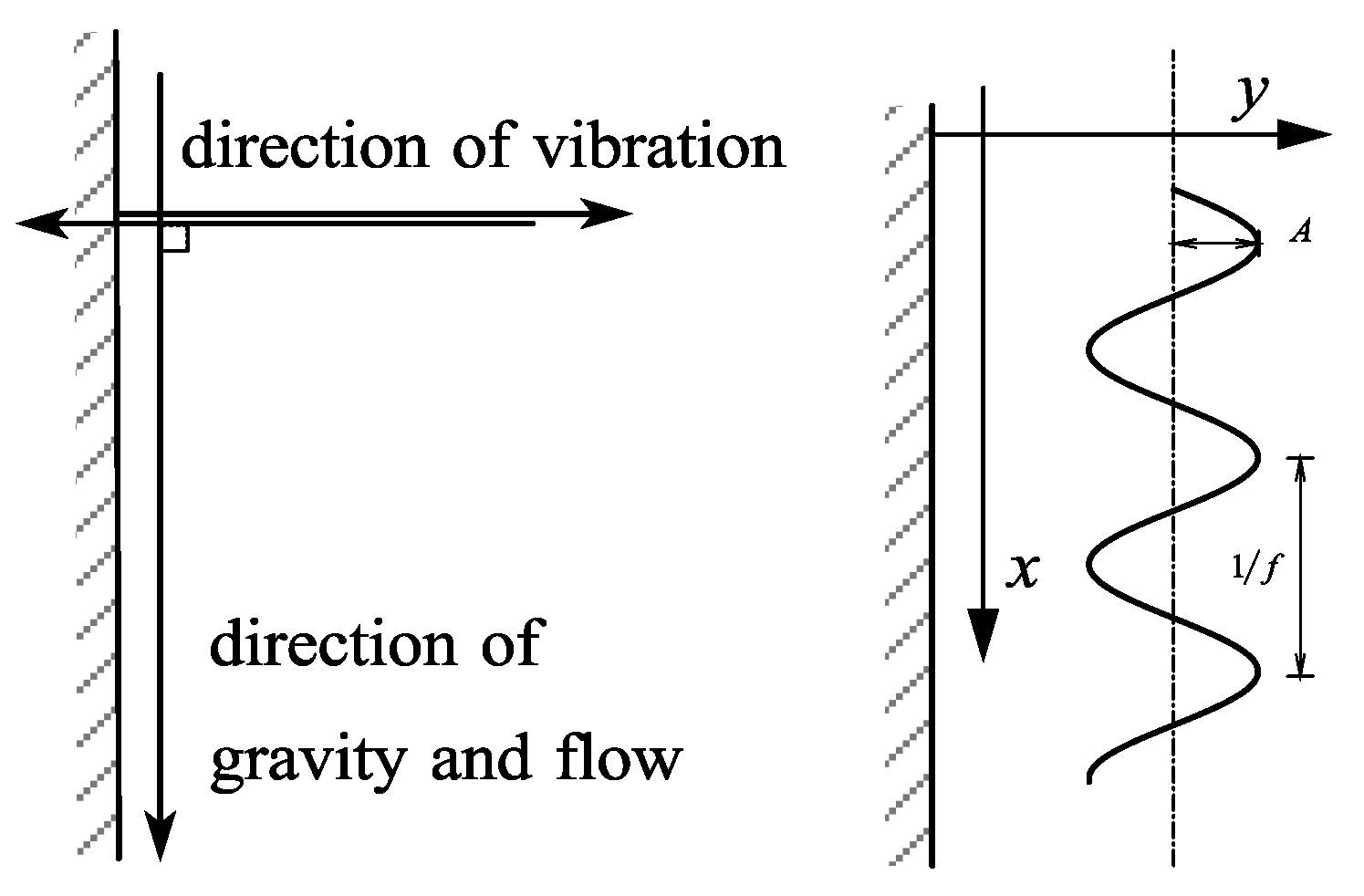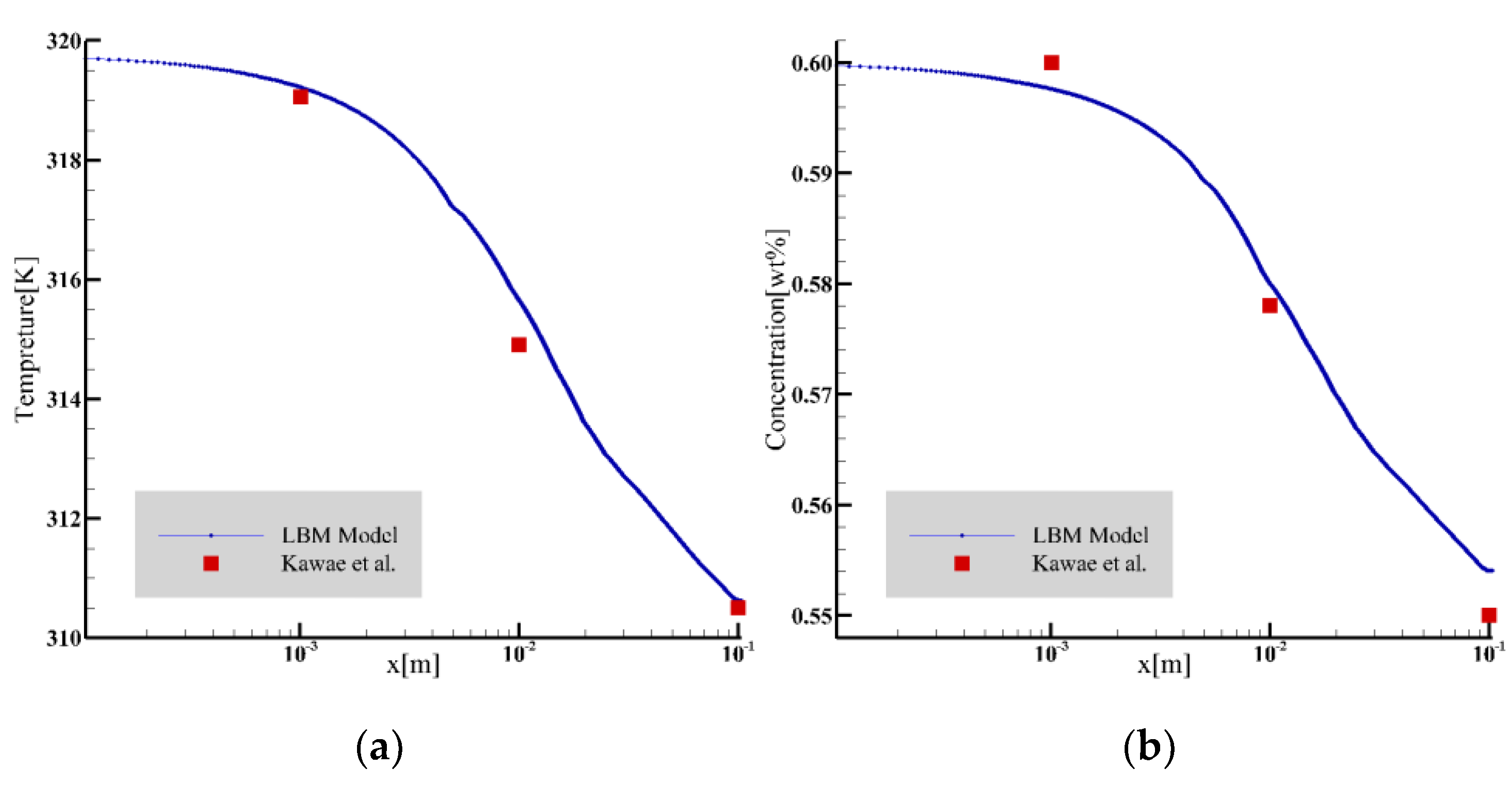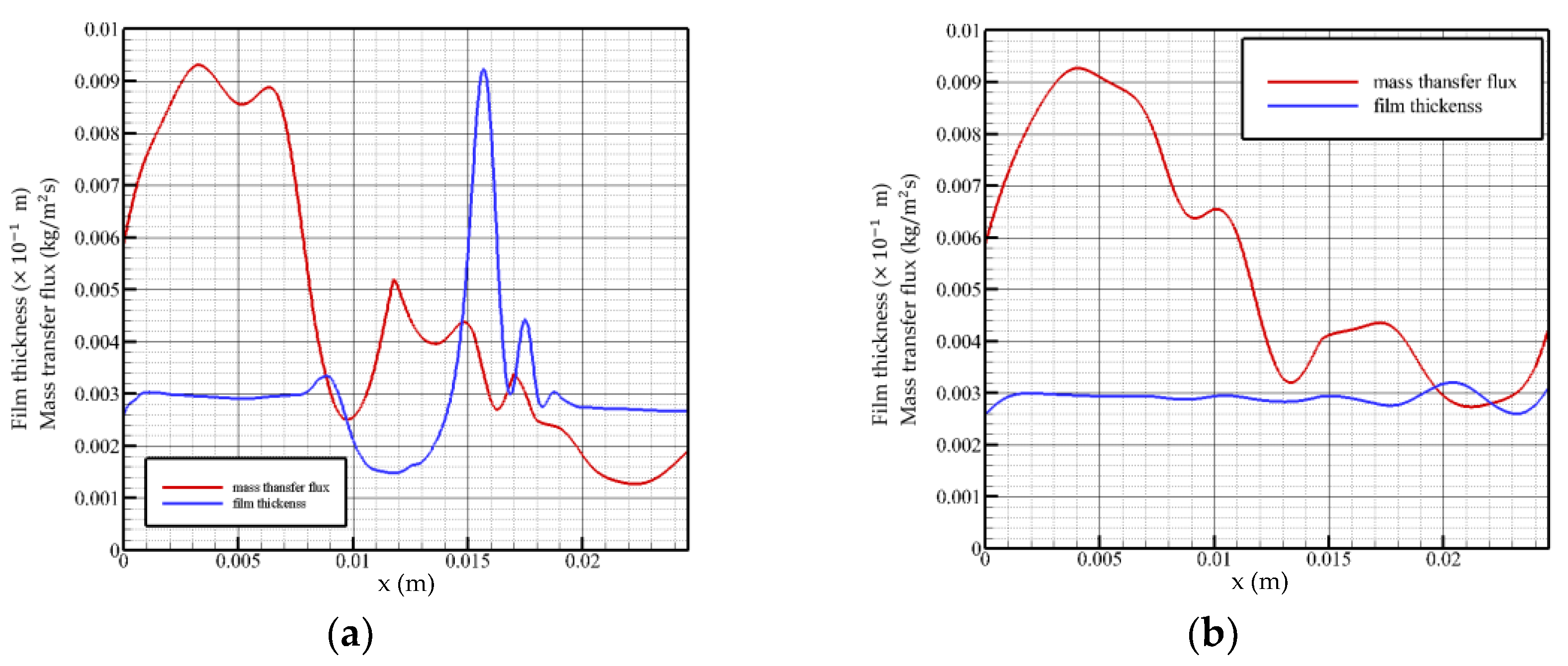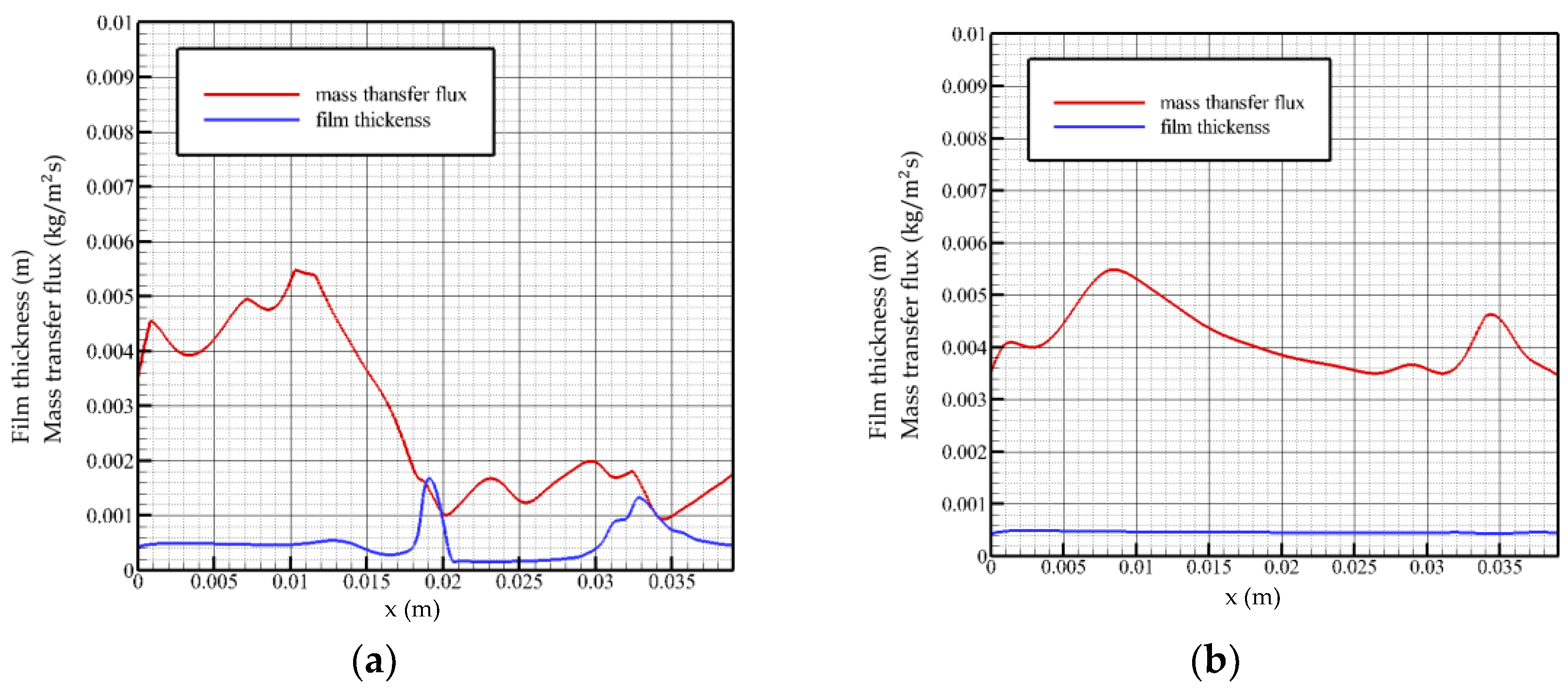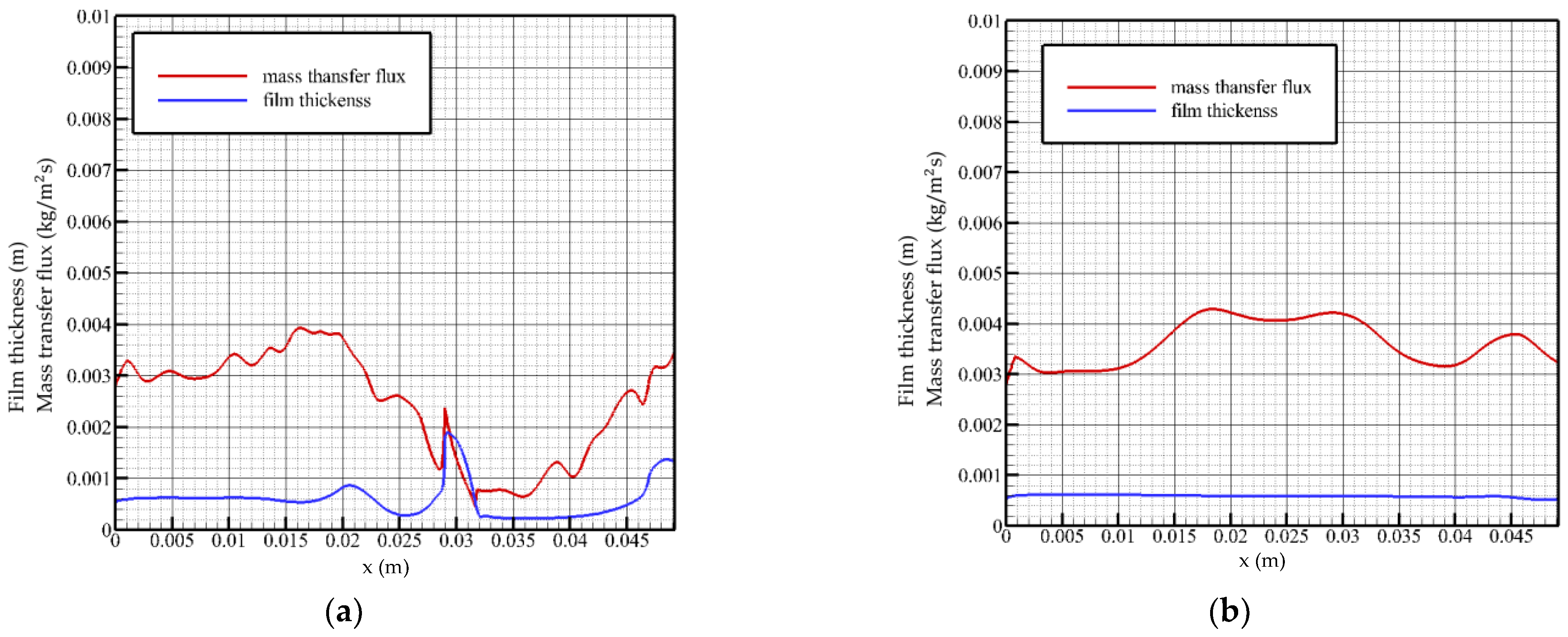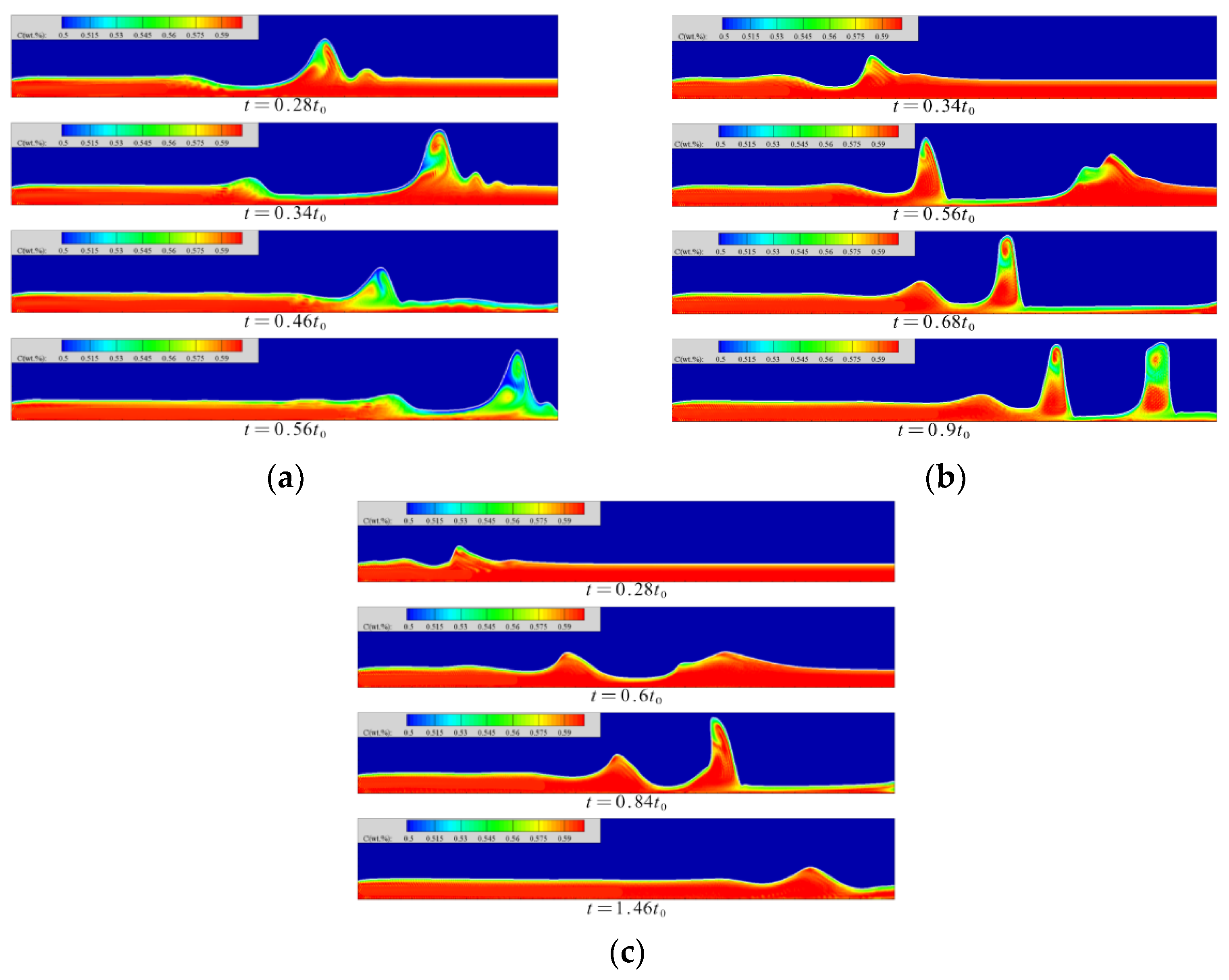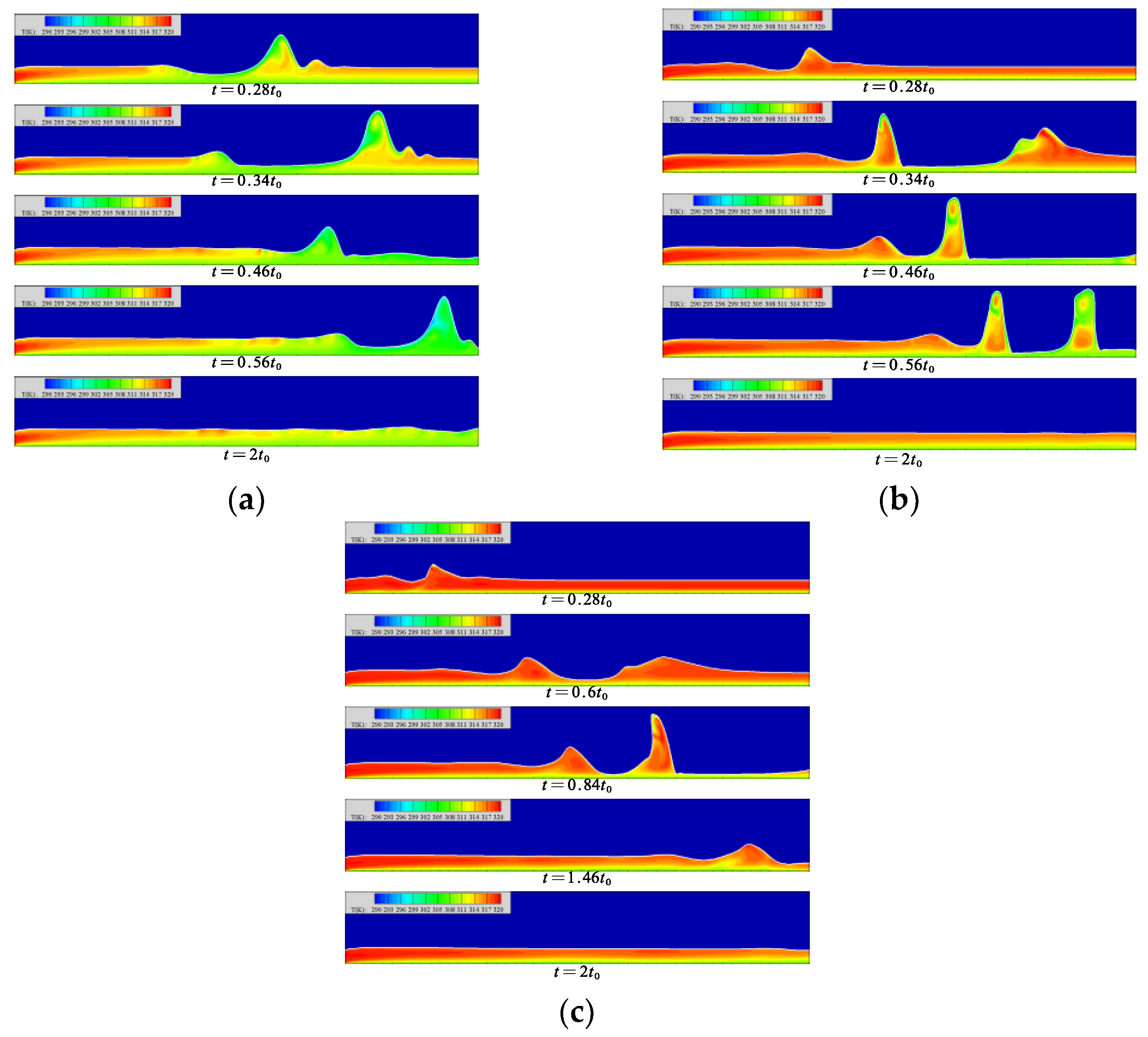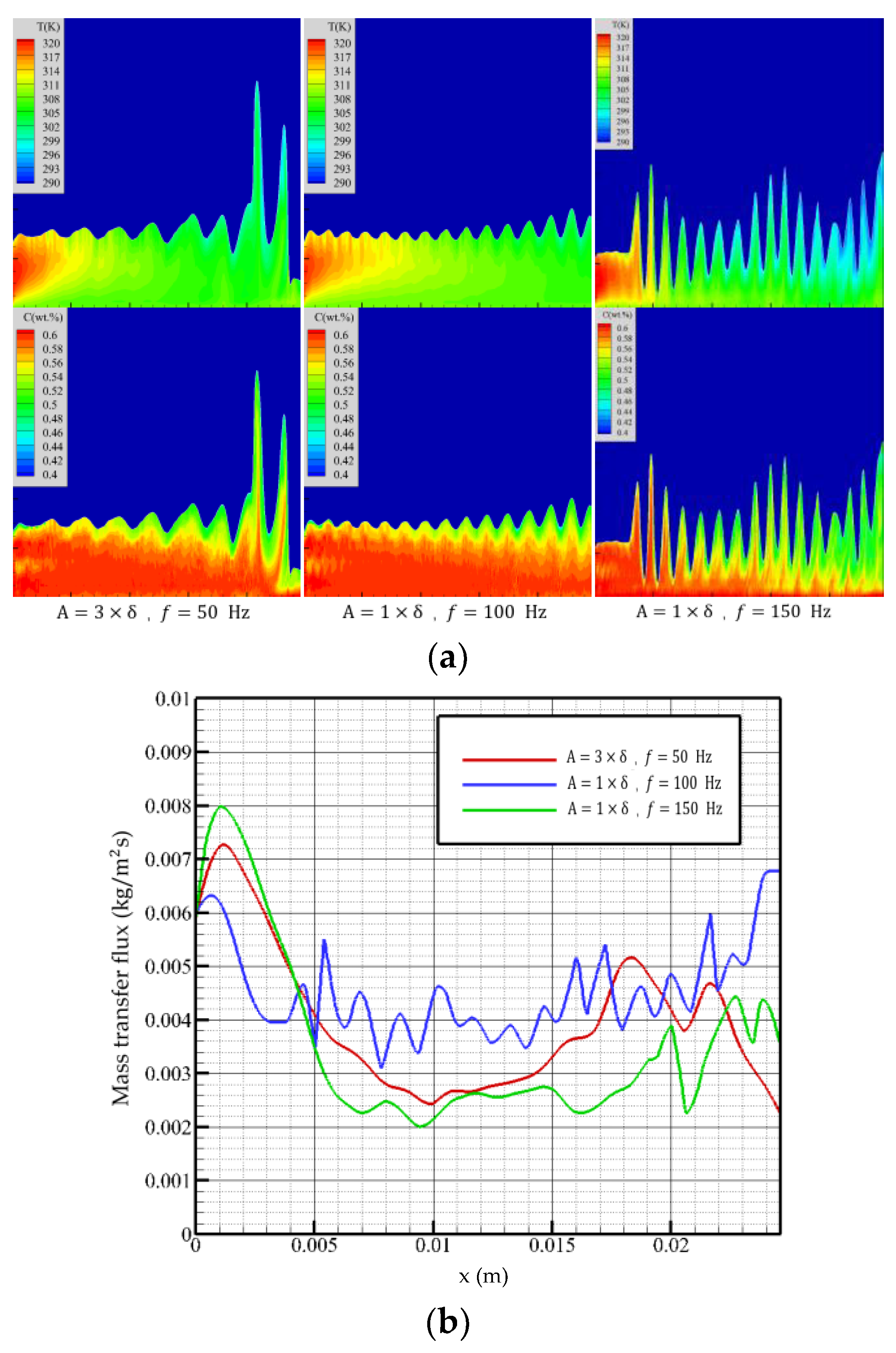4.1. Mass Transfer Flux and Liquid Film Surface Height
When the Reynolds number is 5 and the flow time is
t = 0.28
t0, as shown in
Figure 4a, the surface mass transfer flux surges in the inlet region, followed by a rapid decline to normal levels. When flow length reaches the peak position, the mass transfer flux decreases to a local minimum and turns to increase with the decrease in the liquid film height. On the surface distribution of the liquid film at this moment, the liquid film in front of the solitary wave is squeezed, resulting in a series of tiny fluctuations, and the mass transfer flux fluctuates in the opposite direction in this region. After the surface of the liquid film recovers to a gentle level, the surface mass transfer flux decreases monotonically with the flow distance until the flow field exits.
When the flow time is
t = 2
t0, as shown in
Figure 4b, the solution absorbs steam in the feeding area with a greater intensity. The surface of the liquid film in the state of violent fluctuation has several small disturbances, which make the absorption process of the solution to the vapor also subject to positive disturbance, while the disturbance generated by the surface of the liquid film in the state of smooth flow is not enough to affect the absorption of the film surface, i.e., the transmission process. The overall mass flux declines and maintains at an average level of 0.003 to 0.004 kg/(m
2s). When flow distance reaches the fluctuation region, the mass transfer flux changes in the opposite direction with the change in the liquid film surface height.
Analysis of the change law of the surface mass transfer flux when the Reynolds number is 5 shows that the mass transfer flux changes in the opposite direction with the surface height in the fluctuation region of the film surface: as the liquid film surface height rises, it decreases. However, even if the surface of the liquid film fluctuates violently, the overall change trend of the surface mass transfer flux is still not significantly different from that of the liquid film in a gentle state. Both the velocity and the inlet flow are low, so the mass transfer flux is not sensitive to changes in the liquid film surface.
When the Reynolds number is 20 and the flow time is
t = 0.58
t0, as shown in
Figure 5a, it can be seen that when the liquid film is in a state of violent fluctuation, the surface mass transfer flux begins to decrease after a certain distance behind the solitary wave and maintains a downward trend. At the front wave waist, the surface mass transfer flux reaches a local minimum. In the fluctuating state, the solitary wave front has a slender, thin liquid film, and the surface mass transfer flux begins to increase gradually in the region located in the slender, thin liquid film, indicating that the solution in the thin liquid film region gradually restores the strength of the vapor absorption. This can be explained by concentration and temperature distributions at this time. At inlet, when the liquid film region flows smoothly, the surface mass transfer flux gradually rises to the highest point, and then begins to decrease, indicating that the solution at the liquid film inlet has the greatest absorption strength for steam under steady state. When flowing to the fluctuating region near the outlet, the surface mass transfer flux shows an opposite trend with the change in the liquid film height, which is different from the change trend of the liquid film surface mass transfer flux in the state of severe fluctuation. The mass transfer flux in the state of severe fluctuation reaches a minimum value at the waist of the wave front, while the mass transfer flux in the state of smooth flow reaches a minimum value at the peak of the wave.
When the Reynolds number is 20 and the flow time is
t = 2
t0, as shown in
Figure 5b, near the inlet, the surface mass transfer flux curve shows an upward trend, and the absorption strength of the solution to the vapor gradually increases in this region. Additionally, after reaching the highest point (
x ≈ 0.008 m), it decreases gently, and the overall level of mass transfer flux at this time is more than 0.004 kg/(m
2s). When the flow reaches the fluctuation region near the outlet, the mass transfer flux rises briefly with the disturbance of the liquid film. It can be seen that under the steady flow state, the liquid film fluctuation has a positive excitation on the surface mass transfer flux. When the liquid film height reaches the lowest point, the mass transfer flux curve rises briefly to reach the second peak value and then decreases with the recovery of the liquid film height.
When the Reynolds number is 40 and the flow time is
t = 0.76
t0, as shown in
Figure 6a, near the flow inlet, the mass transfer flux on the surface of the liquid film increases gradually. When the surface of the liquid film fluctuates, the mass transfer flux changes from a gentle change to a downward trend, and a local minimum occurs when the flow distance reaches the wavefront region (
x ≈ 0.028 m), where the absorption strength of steam is weak. When reaching the trough position, the mass transfer flux turns to rise and has a local maximum value and then drops sharply with the steeply rising liquid film surface height. The thickness of the liquid film in the leeward side area decreases as a whole. At this time, due to the good heat exchange environment, the mass transfer flux gradually increases until the level of the inlet is restored. Liquid film fluctuations reduce the average mass transfer flux as a whole.
When the flow time is
t = 2
t0, as shown in
Figure 6b, the change trend of the mass transfer flux is more gradual, and it gradually increases with the flow distance and maintains the overall highest level in the middle region of the flow plate.
When the Reynolds number is 40, the change curve of the mass transfer flux is not exactly opposite to the height of the liquid film surface, and the change curve has a hysteresis characteristic, that is, the location of the minimum value of the mass transfer flux curve lags behind the location of the peak of the wave. The mass transfer flux in the steady state gradually increases at the inlet position, and the overall absorption intensity of the solution in this region gradually increases. When the Reynolds number is 40, the fluctuating region of the liquid film is closer to the outlet, and the mass transfer flux curve fluctuates when it is located in the middle of the flow plate and remains above 0.004 kg/(m2s). It turns to descend when approaching the outlet and varies with the thickness of the liquid film.
Overall, the surface mass transfer flux decreases in the rising region of the liquid film thickness and rises in the falling region. The influence degree increases with the increase in the Reynolds number, and the change trend shows a hysteresis with the increase in the Reynolds number. When the wave crosses the thin liquid film, the concentration diffusion from the liquid film to the wave is promoted. The turbulent solution in the wave drives the solution in the thin liquid film with sufficient heat exchange between the wave front and the back of the wave and pulls it into the wave, which promotes the heat exchange in the wave. When the Reynolds number is low, only the phenomenon of intra-wave turbulence occurs. With the increase in the Reynolds number, the fluctuation phenomenon of the liquid film advancing relatively near the wall surface gradually becomes obvious. However, when the Reynolds number increases to 40, neither turbulence nor relative liquid film migration occurs during the fluctuation process, and the absorption effect is poor.
4.2. Concentration Distribution in Liquid Film
The concentration distribution in the liquid film at each moment is shown in
Figure 7. When the Reynolds number is 5, the absorption effect of the windward surface is better in the initial fluctuation state of the flow. The concentration distribution inside the wave crest shows a counterclockwise disturbance. The absorbed steam on the windward side migrates counterclockwise with the flow in the wave to the leeward side of the solitary wave while diffusing; the absorption intensity of the steam in this area is low, and the absorption of the steam is relatively low. The contribution of the process is not large, so the accumulation of low-concentration solution in this area is beneficial to the smooth progress of the absorption process in other areas. Only when the solitary wave peak reaches a certain height will the phenomenon of spontaneous concentration migration within the wave occur, and when the solitary wave maintains its own height, the internal concentration will continue to migrate until the concentration in the wave reaches a uniform distribution.
At a Reynolds number of 20, in the wave foot area of the windward side of the solitary wave, the concentration of the solitary wave diffuses into the inner wave. The diffusion direction is opposite to the flow direction of the liquid film. There is a thin and thin liquid film behind this area, and the concentration is obviously low. The solitary wave has a faster flow velocity relative to the liquid film. When the thickness of the liquid film in front is sufficient, the fluctuation of the film surface will squeeze the liquid film in front. When the thickness of the liquid film on the front side is lower than a certain threshold, the fluctuation of the film surface no longer squeezes the liquid film on the front side but moves forward relative to the liquid film and finally continues to flow from the top of the film. The region maintains the original diffusion strength. The rear surface wave passes from above, causing the phenomenon that the concentration of the wave trough is reduced. After the low-concentration area is in contact with the high-concentration area, the concentration diffusion intensity increases, which is beneficial to the absorption of the slender and thin liquid film area.
At a Reynolds number of 40, the solution concentration near the inlet and on the windward side of the surface wave is lower. The concentration on the leeward side of the surface wave is always high, and there is a counterclockwise diffusion of the concentration inside the wave crest, but a high concentration band appears in the wave waist, which cuts off the low concentration areas of the wave crest and the wave trough. The surface fluctuation of the film firstly generates a wavelet above the solitary wave; then, the concentration diffusion in the wave is confined within the range of the subwave, and the concentration diffusion in the wave reduces the positive excitation effect of the absorption, which has an adverse effect on the absorption. In addition, the phenomenon of solitary waves flowing from above the low-concentration region in the thin liquid film still occurs. Due to the increase in the Reynolds number, the flow rate and velocity increase synchronously, and the ratio of the wave velocity to the velocity of the liquid film surface gradually decreases, so that the solitary wave gradually decreases. The forward motion of the wave relative to the slender, thin liquid film is not obvious and, finally, the effect of diffusion of the vapor concentration in the thin liquid film into the wave is not as effective as when the Reynolds number is 20.
4.3. Temperature Distribution in Liquid Film
The temperature distribution in the liquid film at each moment is shown in
Figure 8. When the Reynolds number is 5, the temperature in the film gradually decreases with the flow distance, and gradually increases with the height from the wall. When the wave is generated, the motion of the wave pulls the low-temperature solution in this area into the wave. The contact area between the wave surface and the steam gradually increases, but the surface temperature rises insignificantly, which promotes the absorption process of the wave surface.
When the Reynolds number is 20, the average flow rate of the liquid film increases, resulting in an insufficient heat transfer process of the solution. Therefore, when the liquid film flow reaches a gentle level, the minimum temperature of the solution surface is still much higher than the temperature of the cooling wall surface. In the fluctuating state, the mass of the fluctuating surface of the liquid film comes from the wave front and the back of the wave. At the moment of
t = 0.34
t0 in
Figure 8b, the mass of the slender and low-temperature thin liquid film goes to the wave waist of the front wave and the wave peak of the back wave, respectively, and its flow law is in line with the counterclockwise flow of the solution inside the wave. With the movement of the solitary wave, a high-temperature area appears in the middle part of the wave, which separates the upper and lower low-temperature areas. The upper low-temperature area comes from the supply of low-temperature solution on both sides of the wave; the lower low-temperature area comes from the low-speed flow near the heat exchange wall.
When the Reynolds number is 40, the temperature of the liquid film surface remains high. When the liquid film forms a region of lower film thickness, the low-temperature solution migrates to the wave surfaces on both sides. The migration of the solution is not obvious. When the solution migrates to the leeward side of the solitary wave, it is intercepted at the trough of the wavelet, so that the solution in the wave cannot conduct sufficient heat exchange. In the region with lower liquid film thickness on the back side of the wave, the tendency of the low-temperature solution to flow into the wave can be clearly found, but this part of the solution does not finally reach the wave surface. In this region, the flow of the solution into the wave is blocked. The generation of wavelets is not the direct cause of the blocked flow of the low-temperature solution. It may be that the increase in the Reynolds number slows down the counterclockwise flow of the solution in the wave, resulting in insufficient low-temperature solution at the bottom of the liquid film to be drawn into the film.
4.4. Absorption Effects with Vibration
The Reynolds number of 5 is selected to examine the effect of vibration on the absorption. The falling-film absorption effect under different vibration parameters is shown in
Figure 9.
In the vibration state with an amplitude of three times the film thickness and a frequency of 50 Hz, the surface of the liquid film produces continuous fluctuations, which increases the contact area of the film surface with the steam, reduces the overall film thickness, and improves the overall flow performance of the liquid film. The mass transfer flux begins to decrease after reaching the maximum value at the inlet position. Due to the lower vibration frequency, the fluctuation state of the liquid film is similar to that under non-equilibrium disturbance. The influence of the fluctuation at this time on the liquid film absorption process is not obvious. When flow distance reaches the violent fluctuation region, the mass transfer flux decreases with the liquid film height. At the exit, there is an upward trend.
When amplitude is one time the film thickness, and the frequency is 100 Hz, the liquid film fluctuates regularly, and the fluctuation is weaker than that of high amplitude and low frequency. However, the higher frequency makes the solution in the liquid film fully disturbed, which promotes the diffusion of temperature and concentration in the film. When the flow distance is close to the outlet, the mass transfer flux increases with the flow distance and then begins to decline. The overall trend is not significantly different from that of high amplitude and low frequency.
When the amplitude is one time the film thickness, and the frequency is increased to 150 Hz, the higher vibration frequency causes the liquid film to fluctuate violently; the violent fluctuation breaks the characteristics of high absorption intensity at the entrance, and the mass transfer flux first shows a downward trend. It can be seen from
Figure 9 that due to the influence of high-frequency vibration, the temperature and concentration in this area are higher than the first two vibration conditions, so the mass transfer flux is low. With the continuous flow of the liquid film, the violent vibration of the film surface increases the absorption area and, at the same time, has a good heat exchange effect with the cooling wall, so the mass transfer flux always maintains a stable level, and the overall performance is better than the previous two.
The stable flow under vibration conditions is related to the amplitude and vibration frequency, and the lower amplitude and frequency can maintain the normal flow of the liquid film. When vibration frequency increases, the wavelength of the liquid film surface wave decreases. When the surface wave frequency is greater than the surface vorticity change frequency, the irregular wave of the liquid film will be induced. When the liquid film does not peel off, the vibration has a favorable effect on the liquid film absorption. Increasing the amplitude can increase the gas–liquid contact area and obtain a lower average film thickness, while increasing the vibration frequency can promote the internal flow of the solution and the diffusion of concentration and temperature.
